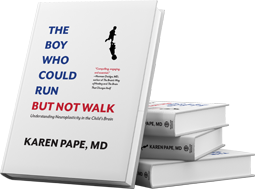 “The Boy Who Could Run but Not Walk: Understanding Neuroplasticity in the Child’s Brain” By Karen Pape, MD
“The Boy Who Could Run but Not Walk: Understanding Neuroplasticity in the Child’s Brain” By Karen Pape, MD
Dr. Pape has inspired a great deal of discussion and debate over the years, some of that within our academy. Her book chronicles the path of a thoughtful physician and extraordinary timing. She had the great fortune and fortitude to study with mentors who were on the cutting edge of diagnosis and treatment and the insight to take what she learned and move forward with it. This book moves through a logical sequence both chronologically as the science of diagnosis and treatment of children and adults with cerebral palsy and brachial plexus injury has advanced as well as Dr. Pape’s education and integration of treatment research and results. She uses patient examples to illustrate treatment principles. Fortuitously, I was present for several of these examples and we often discussed their implications far into the night, using the available research and our observations to postulate possible longer-term treatment potential. These discussions have informed my reading, writing and treatment organization principles. I know she has done the same for many colleagues. She has a gift for finding bright, thoughtful, energetic therapists and physicians (as illustrated in her book) and nudging, budging and thrusting them to their best potential and the potential of their patients. This book is a personal and professional reflection of that winding path. I continue to be impressed with Dr. Pape’s wide and deep investigation and her willingness to credit improvements in treatments for children with cerebral palsy such as SEML’s (single event multi-level orthopedic surgery), CIMT (constraint induced movement therapy) and HABIT (hand-arm bilateral intensive therapy) as examples of intensive interventions that are proven to work.
I urge you to pick up a copy of this book (use Amazon Smile for the AACPDM!) and gain an appreciation for making long term plans for improvement for children and adults. Think about the principles of intensity, alignment, and integrated treatment within your own practice and move forward.